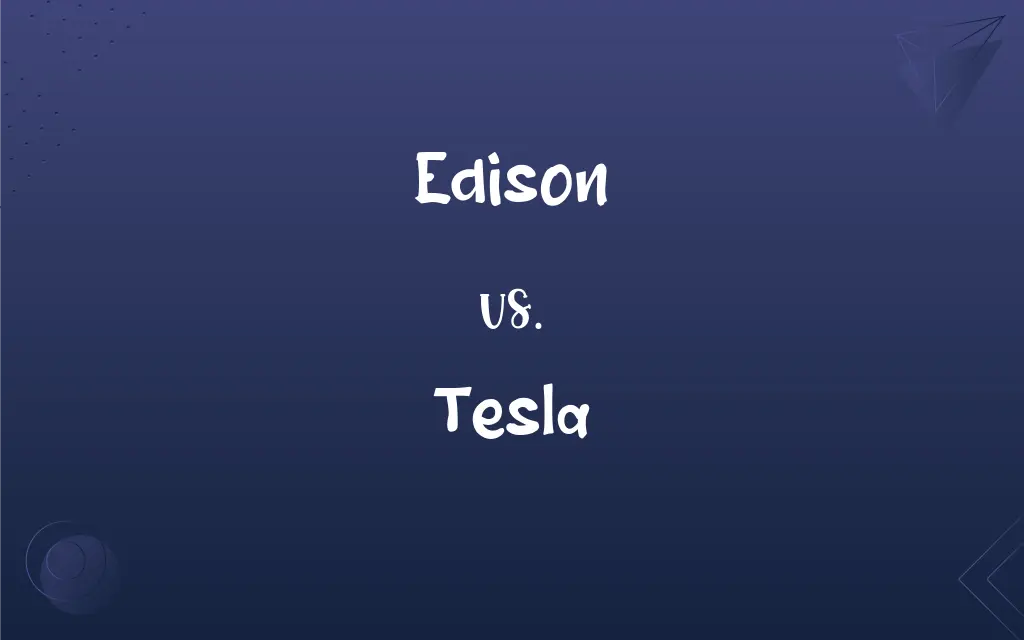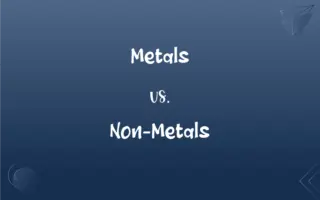Edison vs. Tesla: What's the Difference?
Edited by Aimie Carlson || By Janet White || Published on October 8, 2024
Edison was an American inventor known for the practical electric light bulb and direct current (DC) systems, while Tesla was a Serbian-American inventor, pioneering alternating current (AC) technology.

Key Differences
Thomas Edison, an iconic American inventor and businessman, made significant contributions to the development of practical electric light bulbs and phonographs, focusing on direct current (DC) electrical systems. Nikola Tesla, a Serbian-American inventor and engineer, is renowned for his groundbreaking work in the development of alternating current (AC) electrical systems, which became the dominant electrical system worldwide.
Edison's approach to invention was commercially driven, focusing on creating practical, marketable products and establishing effective manufacturing processes. He founded General Electric, one of the largest and most diversified industrial corporations in the world. Tesla, on the other hand, was more focused on theoretical and experimental aspects of science, contributing to advancements in radio, radar, x-rays, and wireless transmission, though he faced financial struggles and recognition for his work came much later.
Edison's work led to the creation of small, localized power systems using DC, his technology was limited by the inability to transmit power over long distances. Tesla's AC system, in contrast, allowed for the efficient transmission of electricity over vast distances, revolutionizing the electrical industry and leading to widespread electrification.
Edison's legacy is often associated with entrepreneurial spirit and practical invention, holding over 1,000 patents and impacting industries such as electric power generation, mass communication, sound recording, and motion pictures. Tesla, remembered as a visionary and a "mad scientist," held around 300 patents and is celebrated for his contributions to the modern alternating current electrical supply system, despite living much of his life in poverty.
Both Edison and Tesla were instrumental figures in the Second Industrial Revolution, their contributions and rivalry, especially the War of the Currents, highlighted their different approaches to invention and science. Edison's practical and business-minded approach contrasted with Tesla's theoretical and idealistic vision, both leaving an indelible mark on technology and society.
ADVERTISEMENT
Comparison Chart
Nationality
American
Serbian-American
Main Inventions
Practical electric light bulb, phonograph, DC systems
Alternating current (AC) electrical systems, wireless transmission
Business Approach
Entrepreneurial, focused on commercialization and manufacturing
Theoretical, focused on experimentation and invention
Legacy
Over 1,000 patents, General Electric founder
Around 300 patents, pioneer in AC technology
Recognition and Financial Success
Achieved fame and financial success during his lifetime
Gained recognition posthumously, lived in relative poverty
ADVERTISEMENT
Edison and Tesla Definitions
Edison
Edison's work in developing direct current (DC) systems shaped early electrical distribution.
Edison advocated for DC power, believing it was the safest and most efficient form of electrical distribution at the time.
Tesla
Tesla was a visionary Serbian-American inventor, known for pioneering the alternating current (AC) electrical system.
Tesla's AC system revolutionized the way electricity was transmitted and used around the world.
Edison
Edison was a prolific American inventor and businessman, known for his work on the electric light bulb.
Edison's invention of the light bulb illuminated the world and marked the dawn of a new era.
Tesla
Tesla was known for his groundbreaking research in electromagnetism and its practical applications.
Tesla's insights into electromagnetism led to inventions that harnessed the power of magnetic fields for industrial use.
Edison
Edison founded General Electric, a company that became a symbol of American innovation and industrial power.
Through General Electric, Edison left a lasting legacy in various technological and industrial sectors.
Tesla
Tesla's legacy includes around 300 patents, illustrating his role as a prolific inventor and scientist.
Tesla's patents, covering a wide range of technologies, demonstrate his innovative spirit and lasting impact on modern science.
Edison
Edison held over 1,000 patents, showcasing his wide-ranging contributions to science and technology.
Edison's numerous patents reflect his relentless pursuit of innovation and practical solutions.
Tesla
Despite his numerous contributions to science, Tesla spent much of his life in relative obscurity and financial difficulty.
Tesla, despite his genius, struggled with financial and social challenges, overshadowed by his contemporaries.
Edison
Edison's entrepreneurial spirit drove him to transform inventions into viable, marketable products.
Edison's approach went beyond inventing; he excelled in marketing his inventions to the masses.
Tesla
Tesla's work laid the foundation for modern wireless communication and radio technology.
Tesla's experiments with wireless transmission paved the way for today's wireless networks and communication systems.
Edison
United States inventor; inventions included the phonograph and incandescent electric light and the microphone and the Kinetoscope (1847-1931)
Tesla
The SI-derived unit of magnetic flux density, equal to the magnitude of the magnetic field vector necessary to produce a force of one newton on a charge of one coulomb moving perpendicular to the direction of the magnetic field vector with a velocity of one meter per second. It is equivalent to one weber per square meter. See Table at measurement.
Tesla
In the International System of Units, the derived unit of magnetic flux density or magnetic inductivity. Symbol: T
Tesla
A unit of magnetic flux density equal to one weber per square meter
Tesla
United States electrical engineer and inventor (born in Croatia but of Serbian descent) who discovered the principles of alternating currents and developed the first alternating-current induction motor and the Tesla coil and several forms of oscillators (1856-1943)
FAQs
What is Edison's most famous invention?
Edison's most famous invention is the practical electric light bulb.
Who was Nikola Tesla?
Tesla was a Serbian-American inventor known for pioneering the alternating current (AC) electrical system and wireless transmission.
Who was Thomas Edison?
Edison was an American inventor and businessman known for inventions like the light bulb and phonograph.
What was the 'War of the Currents'?
The 'War of the Currents' was a competition between Edison's direct current (DC) and Tesla's alternating current (AC) systems for electrical power distribution.
How many patents did Edison have?
Edison held over 1,000 patents.
What is Tesla's most notable contribution to science?
Tesla's most notable contribution is the development of the alternating current (AC) electrical system.
Did Edison and Tesla work together?
Yes, Tesla briefly worked at Edison's company, but they had differing views and parted ways professionally.
How many patents did Tesla have?
Tesla had around 300 patents.
Did Edison work on alternating current (AC)?
No, Edison was a proponent of direct current (DC) and opposed the use of AC.
What were Tesla's views on wireless transmission?
Tesla was a pioneer in wireless transmission and believed it could be used for global communication and energy transmission.
How did Tesla view invention and innovation?
Tesla saw invention as an exploration of scientific theories and potential, often prioritizing groundbreaking concepts over immediate commercial viability.
Was Edison's work primarily theoretical or practical?
Edison's work was primarily practical and focused on creating functional, marketable inventions.
Was Tesla's work primarily theoretical or practical?
Tesla's work was a mix of theoretical and practical, but he is often remembered for his visionary and theoretical contributions to science.
Did Edison have a formal education?
Edison had limited formal education and was mostly self-taught.
Did Tesla have a formal education?
Yes, Tesla received formal education in engineering and physics.
What is Edison's impact on today's world?
Edison's inventions and industrialization efforts greatly influenced modern technology, manufacturing, and entertainment industries.
How did Edison view invention and innovation?
Edison viewed invention as a process of practical experimentation and commercialization, focusing on tangible, marketable products.
What is Tesla's impact on today's world?
Tesla's work on AC electricity and wireless technology laid the foundation for modern power distribution and communication systems.
Did Tesla work on direct current (DC)?
Tesla initially worked on DC projects but is most famous for his work on alternating current (AC).
What company did Edison found?
Edison founded General Electric.
About Author
Written by
Janet WhiteJanet White has been an esteemed writer and blogger for Difference Wiki. Holding a Master's degree in Science and Medical Journalism from the prestigious Boston University, she has consistently demonstrated her expertise and passion for her field. When she's not immersed in her work, Janet relishes her time exercising, delving into a good book, and cherishing moments with friends and family.
Edited by
Aimie CarlsonAimie Carlson, holding a master's degree in English literature, is a fervent English language enthusiast. She lends her writing talents to Difference Wiki, a prominent website that specializes in comparisons, offering readers insightful analyses that both captivate and inform.






































































